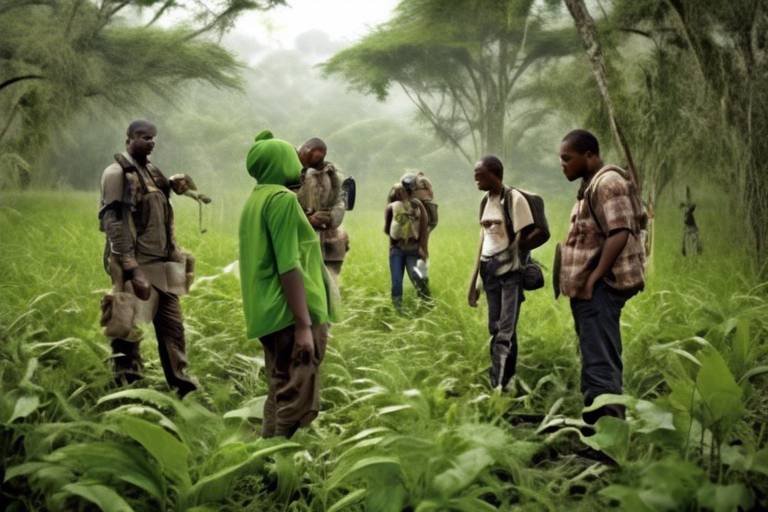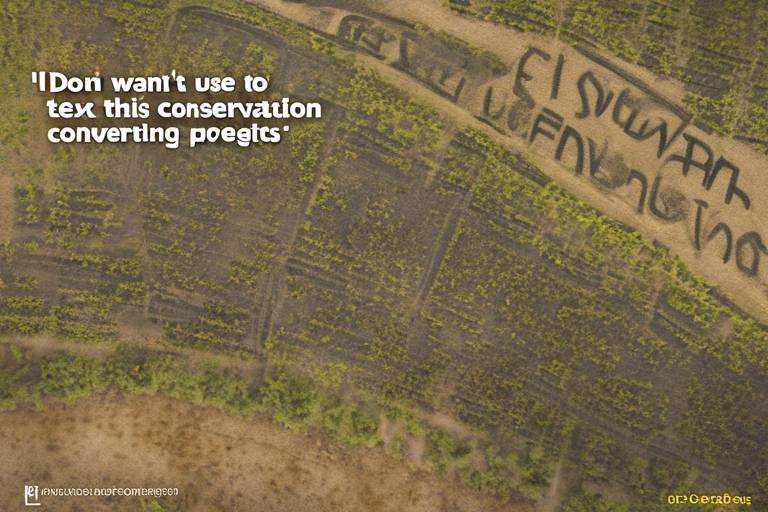The Division of Green: Understanding Socio-economic Disparities in Conservation Efforts
In our rapidly changing world, the intersection of socio-economic factors and conservation efforts has become a pivotal topic of discussion. The phrase "The Division of Green" encapsulates the stark contrasts in how different communities engage with and benefit from conservation initiatives. It's not just about protecting the environment; it's about understanding the underlying inequalities that shape these efforts. Why do some communities thrive in their conservation endeavors while others struggle? The answer lies in a complex web of socio-economic disparities that influence funding, access, and community involvement.
Throughout history, conservation practices have evolved, often reflecting the socio-economic landscape of the time. From the early days of wildlife protection to modern biodiversity initiatives, each phase of conservation has been influenced by the economic and social contexts in which they were developed. For instance, affluent communities often have greater access to resources, allowing them to implement and sustain effective conservation strategies. In contrast, marginalized communities may lack the necessary funding and support, leading to a cycle of neglect and environmental degradation.
As we delve deeper into the socio-economic factors influencing conservation, we find that income levels, education, and social status are not just statistics; they are the building blocks of community engagement. Communities with higher income levels tend to have better access to educational resources, which fosters a greater understanding of environmental issues. This knowledge translates into active participation in conservation efforts, creating a positive feedback loop that benefits both the environment and the community. However, when we look at lower-income areas, we often see a stark contrast—limited resources, less educational outreach, and consequently, lower participation rates in conservation initiatives.
One of the most significant barriers to effective conservation is the disparity in access to resources. Many communities face challenges in securing financial backing for conservation projects. Funding disparities can lead to a lack of opportunities for various communities, leaving some areas underrepresented in conservation discussions. Moreover, educational access plays a crucial role in raising awareness about the importance of conservation. Without proper education, communities may not understand the value of preserving their natural resources, resulting in a disconnect between the environment and the people who inhabit it.
Community engagement is the lifeblood of successful conservation initiatives. When local residents are actively involved, conservation efforts are more likely to succeed. However, socio-economic status can significantly influence participation levels. In affluent areas, community members often have the time and resources to dedicate to conservation projects, while those in lower-income neighborhoods may struggle to find the bandwidth to engage fully. This disparity not only affects the success of individual initiatives but also perpetuates a cycle of inequality in conservation efforts.
In conclusion, understanding the socio-economic factors that shape conservation efforts is essential for creating effective and equitable environmental policies. As we explore the historical context, the current disparities, and the potential for inclusive strategies, we can begin to envision a future where all communities have the opportunity to contribute to and benefit from conservation. The road ahead is challenging, but with a commitment to equity and inclusion, we can bridge the divide and foster a more sustainable world for everyone.
- What are socio-economic disparities in conservation? Socio-economic disparities refer to the unequal distribution of resources, opportunities, and privileges among different communities, which affects their ability to engage in and benefit from conservation efforts.
- How do funding disparities impact conservation efforts? Funding disparities can lead to unequal opportunities for communities, resulting in some areas receiving more support and resources for conservation projects, while others are left behind.
- Why is community engagement important in conservation? Community engagement is crucial because local involvement ensures that conservation efforts are relevant and effective, leading to better environmental outcomes and increased support from residents.
- What strategies can promote inclusive conservation? Strategies such as policy changes, community-led initiatives, and increased access to education and resources can help bridge the socio-economic gap in conservation efforts.

Historical Context of Conservation Efforts
Conservation efforts have a rich and complex history that dates back centuries, shaped significantly by socio-economic factors. In the early days, conservation was often a privilege of the wealthy, who sought to protect nature not just for its intrinsic value, but also for recreational purposes. The establishment of national parks in the late 19th and early 20th centuries, particularly in countries like the United States, marked a significant shift in how society viewed natural resources. However, these initiatives often overlooked the rights and needs of indigenous populations and local communities, leading to a disconnect between conservation goals and the realities of those who lived closest to the land.
As we moved into the mid-20th century, the environmental movement gained momentum, fueled by increasing awareness of the impacts of industrialization and urbanization on natural ecosystems. This period saw the emergence of environmental laws and policies aimed at protecting wildlife and habitats. Yet, socio-economic disparities continued to play a crucial role in shaping these policies. Wealthier nations were able to allocate substantial resources towards conservation, while developing countries struggled with limited funding and competing priorities, such as poverty alleviation and economic development.
In examining the historical context, it's essential to recognize how socio-economic factors have influenced the effectiveness of conservation initiatives. For instance, in many regions, conservation efforts have been implemented without adequate consultation with local communities, leading to resistance and conflict. This has often resulted in a 'top-down' approach, where decisions are made by policymakers far removed from the realities on the ground. Conversely, when conservation initiatives include local voices and perspectives, they tend to be more successful and sustainable.
To illustrate this point, consider the following timeline of key events in the evolution of conservation efforts:
| Year | Event | Impact on Conservation |
|---|---|---|
| 1872 | Yellowstone National Park established | First national park, influencing global conservation efforts |
| 1962 | Silent Spring published | Raised awareness about environmental issues, spurring the modern environmental movement |
| 1970 | First Earth Day celebrated | Mobilized public support for environmental protection |
| 1992 | Earth Summit in Rio de Janeiro | Global acknowledgment of sustainable development and biodiversity |
This timeline highlights pivotal moments that not only shaped conservation policy but also reflected the socio-economic landscape of their times. The evolution of conservation efforts has been a balancing act between protecting nature and addressing the needs of communities. As we move forward, understanding this historical context is crucial for creating more equitable and effective conservation strategies that engage all socio-economic groups.

Socio-economic Factors Influencing Conservation
When it comes to conservation, the impact of socio-economic factors cannot be overstated. These factors play a crucial role in shaping how communities engage with conservation efforts and influence the overall effectiveness of these initiatives. It’s like trying to grow a garden without understanding the soil; if you don’t know what you’re working with, your plants might struggle to thrive. Similarly, conservation efforts can falter when socio-economic disparities are ignored.
First and foremost, let’s talk about income levels. Communities with higher income levels often have greater access to resources, including funding for conservation projects. This financial backing allows them to implement more effective strategies, hire professionals, and engage in advanced research. On the other hand, lower-income communities may lack the necessary funds to participate fully in conservation efforts, leading to a cycle where the rich get richer in terms of environmental protection, while the poor struggle to keep their local ecosystems intact.
Education is another critical factor. Imagine a community that is unaware of the importance of biodiversity; they’re less likely to engage in conservation efforts. In areas where educational resources are scarce, people may not understand the implications of environmental degradation or the benefits of sustainable practices. This lack of awareness can lead to apathy toward conservation initiatives, making it challenging to foster community involvement. Therefore, investing in education is not just a moral obligation; it’s a strategic necessity for successful conservation.
Access to resources goes beyond just financial support. It encompasses educational opportunities, technological tools, and even social networks that can facilitate conservation efforts. In many cases, communities that lack these resources find themselves at a disadvantage. For instance, a rural community might have a wealth of traditional knowledge about local flora and fauna but may not have the technological tools to document or share this information effectively. This gap can hinder their ability to engage in meaningful conservation.
Take a look at the funding landscape for conservation projects. It’s often dominated by large organizations and governmental bodies that prioritize certain areas over others. This uneven distribution of funds can create significant disparities. For example, urban areas may receive more financial support due to their visibility and the political clout of their residents, while rural communities, which may have equally pressing conservation needs, are left struggling. This situation not only affects the projects themselves but also perpetuates a sense of disenfranchisement among those communities.
Moreover, educational access is a double-edged sword. Communities with robust educational systems can cultivate a generation of environmentally conscious individuals who are eager to participate in conservation. In contrast, communities with limited educational opportunities may find themselves stuck in a cycle of ignorance regarding sustainable practices. To illustrate this point, consider the following table:
| Community Type | Average Income | Educational Access | Conservation Participation Rate |
|---|---|---|---|
| Urban | $75,000 | High | 70% |
| Suburban | $60,000 | Medium | 50% |
| Rural | $40,000 | Low | 30% |
This table highlights how socio-economic factors can create a stark contrast in conservation participation rates across different community types. The more resources and education a community has, the more likely they are to engage in effective conservation efforts.
In summary, socio-economic factors are the bedrock upon which conservation efforts are built. Understanding these influences is crucial for developing strategies that are not only inclusive but also effective. By addressing income disparities, improving educational access, and ensuring equitable resource distribution, we can foster a more engaged and informed public, ultimately leading to more successful conservation initiatives.
- What are socio-economic factors? Socio-economic factors refer to the social and economic conditions that influence individuals and communities, including income, education, and social status.
- How do income levels affect conservation efforts? Higher income levels often lead to better access to resources and funding, enabling more effective conservation initiatives.
- Why is education important in conservation? Education fosters awareness and understanding of environmental issues, encouraging community involvement in conservation efforts.
- What can be done to bridge socio-economic gaps in conservation? Strategies include increasing funding for underprivileged communities, improving educational access, and promoting grassroots initiatives.

Access to Resources
Access to resources plays a pivotal role in shaping the effectiveness of conservation efforts across various communities. When we talk about resources, we're not just referring to financial backing; we're also considering educational tools, training programs, and even the availability of natural spaces for conservation activities. Imagine trying to build a house without the right tools or materials—this analogy holds true for conservation initiatives as well. If communities lack the necessary resources, their ability to engage in meaningful conservation work diminishes significantly.
One of the most glaring disparities in conservation efforts is the unequal access to financial resources. Wealthier communities often have the means to secure funding for projects, while lower-income regions may struggle to attract even minimal support. This funding gap can lead to a cycle of neglect where underprivileged areas are left out of critical conservation discussions and initiatives. For instance, a community with robust financial backing can afford to hire experts, conduct research, and implement advanced conservation technologies, whereas a less affluent community might rely solely on volunteer efforts and outdated methods.
Furthermore, educational resources are equally important. Education fosters awareness and understanding of environmental issues, empowering individuals to take action. In communities where educational opportunities are limited, there is often a corresponding lack of awareness about the importance of conservation. This lack of knowledge can lead to apathy towards local environmental issues, perpetuating a cycle where conservation efforts are minimal or entirely absent. For example, a community that has access to workshops, seminars, and outreach programs is more likely to develop a culture of conservation compared to one that lacks such educational initiatives.
To illustrate how access to resources can vary significantly, consider the following table that outlines the differences in resource availability between affluent and underprivileged communities:
| Resource Type | Affluent Communities | Underprivileged Communities |
|---|---|---|
| Financial Support | High - Multiple funding sources | Low - Limited grants and donations |
| Educational Programs | Extensive - Workshops, seminars, and training | Minimal - Few outreach programs |
| Community Engagement | High - Active participation in initiatives | Low - Limited involvement and awareness |
In summary, the disparities in access to resources create significant barriers to effective conservation efforts. Without adequate funding and educational opportunities, communities are left struggling to engage in meaningful environmental stewardship. It's essential that we recognize these disparities and work towards creating a more equitable framework for conservation, ensuring that every community, regardless of socio-economic status, has the tools and knowledge necessary to protect our planet.
- What are the main resources needed for effective conservation?
Effective conservation requires financial resources, educational tools, community engagement, and access to natural spaces. - How can communities improve access to conservation resources?
Communities can seek partnerships with non-profits, apply for grants, and engage in educational outreach to improve resource access. - Why is education important in conservation efforts?
Education raises awareness and empowers individuals to take action, leading to more effective conservation practices.

Funding Disparities
When we talk about conservation, funding is like the lifeblood that keeps the whole ecosystem of efforts alive. However, the reality is that funding for conservation projects is often unevenly distributed, leading to significant disparities that can affect the success of these initiatives. Imagine a garden where some plants receive all the water and nutrients, while others wither away in the dry soil. This analogy captures the essence of funding disparities in conservation.
For instance, wealthy regions often have access to substantial financial resources, allowing them to implement advanced conservation techniques and engage in large-scale projects. In contrast, underfunded areas struggle to keep their natural resources intact, facing challenges such as habitat degradation and loss of biodiversity. The lack of funds not only hampers the effectiveness of conservation efforts but also discourages local communities from participating in these initiatives.
To illustrate, let’s take a look at some statistics that highlight the funding disparities:
| Region | Annual Conservation Funding | Population | Funding per Capita |
|---|---|---|---|
| Wealthy Region A | $10 million | 100,000 | $100 |
| Underfunded Region B | $1 million | 200,000 | $5 |
As shown in the table, the disparity in funding is stark. Wealthy Region A receives ten times the funding of Underfunded Region B, yet the latter has a larger population to support. This imbalance creates a situation where the wealthier community can afford to protect its environment effectively, while the other community struggles to make ends meet, let alone invest in conservation.
Moreover, funding disparities are often compounded by socio-economic factors. Areas with lower income levels may not only receive less funding but also face additional challenges, such as limited access to grant opportunities and partnerships with organizations that could provide financial support. This creates a vicious cycle where the lack of initial funding leads to fewer successful conservation projects, which in turn makes it harder to attract future investments.
In conclusion, addressing funding disparities is crucial for creating a more equitable approach to conservation. By ensuring that all regions, regardless of their socio-economic status, have access to adequate funding, we can foster a more inclusive environment where every community has the opportunity to participate in and benefit from conservation efforts. It's not just about saving the planet; it's about creating a sustainable future for all.

Educational Access
Education serves as the cornerstone of effective conservation efforts, yet it remains a privilege that is not equally accessible to all. In many communities, especially those grappling with economic hardship, educational opportunities can be severely limited. This lack of access creates a significant barrier to understanding the importance of conservation and participating in related initiatives. Imagine trying to navigate a dense forest without a map; that's what it's like for communities without proper educational resources when it comes to environmental stewardship.
When individuals lack knowledge about their local ecosystems, they may not recognize the value of conservation efforts or their role within them. For instance, without education on sustainable practices, communities might resort to methods that harm the environment, such as overfishing or deforestation. Therefore, enhancing educational access is not just a moral imperative; it is essential for fostering a culture of conservation that is informed and engaged.
Moreover, educational disparities often align with socio-economic status. Wealthier communities typically have better access to quality education, which includes programs focused on environmental science and conservation. In contrast, underprivileged areas may struggle to provide even basic education, let alone specialized training in conservation practices. This imbalance leads to a cycle where those most affected by environmental degradation are often the least equipped to combat it.
To illustrate the impact of educational access on conservation efforts, consider the following table that summarizes key factors:
| Factor | Wealthy Communities | Underprivileged Communities |
|---|---|---|
| Access to Environmental Education Programs | High | Low |
| Awareness of Conservation Issues | High | Low |
| Participation in Conservation Initiatives | High | Low |
Efforts to improve educational access must focus on creating tailored programs that address the unique needs of various communities. This could involve partnerships between schools, local governments, and environmental organizations to develop curricula that emphasize the importance of biodiversity, conservation techniques, and sustainable practices. For example, incorporating hands-on activities such as community gardens or recycling projects can make learning about conservation engaging and relevant.
Furthermore, technology can play a crucial role in bridging the educational gap. Online resources and virtual workshops can provide valuable information to those in remote or economically disadvantaged areas. By leveraging technology, we can democratize access to knowledge, allowing everyone to participate in the conversation about conservation and take action in their communities.
In conclusion, educational access is a vital component of successful conservation efforts. By ensuring that all communities have the tools and knowledge they need, we can cultivate a more inclusive approach to environmental stewardship that benefits both people and the planet.
- Why is educational access important for conservation? Educational access equips communities with the knowledge and skills needed to engage in effective conservation practices, fostering a culture of environmental stewardship.
- How can technology improve educational access in conservation? Technology can provide online resources and virtual learning opportunities, making conservation education accessible to remote or economically disadvantaged communities.
- What role do local governments play in enhancing educational access? Local governments can partner with schools and organizations to develop tailored educational programs that address the unique needs of their communities.

Community Engagement in Conservation
Community engagement is the heartbeat of effective conservation efforts. When local people are involved, initiatives not only gain valuable insights but also foster a sense of ownership and responsibility towards the environment. Think of it this way: if you own a garden, you're more likely to nurture it, right? The same principle applies to conservation. When communities are actively engaged, they become stewards of their natural resources, ensuring that preservation efforts are not just top-down mandates but grassroots movements that resonate with the community's values and needs.
However, the level of engagement varies significantly across different socio-economic groups. In wealthier areas, communities often have more access to resources, education, and networks that facilitate participation in conservation efforts. Conversely, in underprivileged regions, limited access to information and financial resources can create barriers to involvement. This disparity can lead to a situation where the voices of marginalized communities are overlooked, resulting in conservation strategies that fail to address local realities. It's crucial to recognize that effective conservation is not just about protecting nature; it's about empowering people.
To illustrate this point, consider the following factors that influence community engagement in conservation:
- Awareness and Education: Communities that receive education about environmental issues are more likely to participate in conservation activities. Educational programs can spark interest and provide the necessary knowledge for effective engagement.
- Access to Resources: Financial and material support can significantly impact a community's ability to engage in conservation. When resources are available, communities can implement their own projects, leading to innovative solutions tailored to local needs.
- Social Cohesion: Strong community bonds foster collaboration and collective action. In areas where social ties are weak, it can be challenging to mobilize people for conservation efforts.
Moreover, community engagement is not a one-size-fits-all approach. Different regions have unique cultural, social, and economic contexts that shape how communities interact with their environment. For instance, indigenous communities often have deep-rooted connections to their land, which can inform sustainable practices that benefit both the environment and the community. On the other hand, urban communities may prioritize different aspects of conservation, such as green spaces and pollution reduction. Understanding these nuances is essential for developing effective conservation strategies that resonate with diverse populations.
In conclusion, fostering community engagement in conservation is not just beneficial; it's essential for the success of environmental initiatives. By addressing socio-economic disparities and ensuring that all voices are heard, we can create a more inclusive approach to conservation. This will not only enhance biodiversity preservation but also enrich the lives of individuals and communities across the globe.
- Why is community engagement important in conservation?
Community engagement ensures that conservation efforts are relevant, effective, and sustainable. When local people are involved, they are more likely to support and participate in initiatives that protect their environment. - How can socio-economic disparities affect conservation efforts?
Disparities in income, education, and access to resources can create barriers to participation in conservation. Communities with fewer resources may struggle to engage effectively, leading to unequal outcomes in conservation initiatives. - What role does education play in community engagement?
Education raises awareness about environmental issues and empowers communities to take action. It provides the knowledge needed to understand the importance of conservation and how to get involved. - How can we promote inclusive conservation?
Strategies such as policy changes, community-led initiatives, and targeted educational programs can help bridge the socio-economic gap in conservation efforts, ensuring that all communities have the opportunity to participate.

Case Studies of Disparities
In the realm of conservation, the impact of socio-economic disparities can be vividly illustrated through various case studies. These examples not only highlight the challenges faced but also showcase successful initiatives that have managed to bridge the gap. One notable case is the conservation project in the Amazon rainforest, where indigenous communities have been pivotal in protecting their ancestral lands. However, these communities often lack the financial resources and political support necessary to enforce conservation laws effectively. This disparity in power and funding leads to ongoing deforestation, despite the community's desire to preserve their environment.
On the flip side, we have the success story of the Great Green Wall initiative in Africa. This ambitious project aims to combat desertification and restore 100 million hectares of land across the Sahel region. What makes this initiative stand out is its inclusive approach, engaging local communities in decision-making processes. By providing training and resources, the project has empowered these communities to take ownership of their environment, leading to significant improvements in both biodiversity and local livelihoods.
However, not all stories have a happy ending. A case study in the Caribbean reveals how socio-economic inequalities can hinder conservation efforts. In this region, wealthy tourist resorts often have better access to funding and resources for environmental protection compared to local fishing communities. This imbalance creates tension and conflict, as local fishermen find themselves unable to compete with the environmentally friendly practices employed by resorts that have the financial backing to implement advanced conservation techniques. The result is a decline in fish populations, which directly affects the livelihoods of the local communities.
To better illustrate these disparities, we can take a look at the following table that summarizes key differences in conservation efforts across various regions:
| Region | Community Involvement | Funding Sources | Outcomes |
|---|---|---|---|
| Amazon Rainforest | Low | Government and NGOs | Deforestation continues |
| Great Green Wall (Africa) | High | International aid and local investments | Restoration of land and biodiversity |
| Caribbean | Medium | Tourism revenue | Conflict and resource depletion |
These case studies reveal a stark reality: socio-economic factors play a crucial role in the success or failure of conservation efforts. Understanding these disparities is essential for developing strategies that foster equitable participation in conservation initiatives. By recognizing the unique challenges faced by different communities, we can work towards more inclusive and effective environmental stewardship.

Successful Initiatives
When we talk about successful conservation initiatives, it's essential to highlight projects that have not only made a significant impact on the environment but have also engaged diverse socio-economic groups. One shining example is the Great Green Wall initiative in Africa, which aims to combat desertification and enhance food security across the Sahel region. This ambitious project involves planting trees across an 8,000 km stretch from Senegal to Djibouti, and it has seen participation from local communities, governments, and NGOs. The success of this initiative lies in its ability to unite different socio-economic backgrounds, empowering local farmers and communities to take part in restoring their environment.
Another inspiring case is the Community Forest Management programs in Nepal. These programs have transformed the way local communities interact with their forests, allowing them to manage resources sustainably while also reaping economic benefits. By giving communities ownership and responsibility over forest resources, these initiatives have led to a remarkable increase in forest cover and biodiversity. The key to their success is the recognition that local knowledge and involvement are invaluable in conservation efforts.
Furthermore, the Coral Triangle Initiative in Southeast Asia showcases how collaborative efforts can yield positive results. This region, known for its rich marine biodiversity, has seen local fishers, scientists, and governments come together to create marine protected areas. The involvement of local communities has been crucial, as their traditional knowledge contributes to more effective management practices. The initiative not only protects marine life but also supports the livelihoods of those who depend on these resources.
These successful initiatives share common characteristics that contribute to their effectiveness:
- Community Involvement: Engaging local populations ensures that conservation efforts are relevant and tailored to the specific needs of the community.
- Education and Awareness: Raising awareness about the importance of conservation fosters a sense of responsibility and encourages participation.
- Collaborative Efforts: Partnerships between governments, NGOs, and communities amplify resources and expertise, leading to more impactful outcomes.
By studying these successful initiatives, we can glean valuable lessons about the importance of inclusivity and community engagement in conservation efforts. They remind us that when diverse socio-economic groups come together, the potential for positive environmental change is not just possible but profoundly impactful.
- What is the Great Green Wall initiative? The Great Green Wall is an African-led project aimed at combating desertification and improving food security by planting trees across the Sahel region.
- How do community forest management programs work? These programs empower local communities to manage their forests sustainably, leading to increased forest cover and biodiversity while providing economic benefits.
- What is the Coral Triangle Initiative? This initiative focuses on protecting marine biodiversity in the Coral Triangle region by involving local fishers and communities in the management of marine protected areas.

Challenges Faced
When it comes to conservation efforts, the road is often fraught with challenges, particularly when socio-economic disparities come into play. These challenges can create significant barriers that hinder effective environmental protection and biodiversity preservation. Imagine trying to build a sturdy house on a shaky foundation; that's what happens when socio-economic inequalities are not addressed in conservation initiatives. Communities with limited resources often find themselves grappling with a multitude of obstacles that can stifle their engagement and effectiveness in conservation efforts.
One of the primary challenges is the lack of funding. Many conservation projects rely heavily on financial support, and when this funding is unevenly distributed, it leads to a stark divide in the ability of different communities to participate. For example, affluent regions may attract significant investments for conservation projects, while underprivileged areas struggle to secure even minimal funding. This disparity not only affects the quality of the initiatives but also the communities' morale and sense of ownership over their natural resources.
Moreover, inadequate educational opportunities pose another significant hurdle. In many cases, communities lacking access to quality education are less aware of the importance of conservation, leading to lower participation rates. Without proper education, individuals might not understand the long-term benefits of preserving biodiversity or the implications of environmental degradation. This lack of awareness can perpetuate a cycle of neglect, where communities do not engage in conservation efforts simply because they do not see the value in them.
Additionally, socio-economic status can influence community cohesion. In areas where poverty is rampant, community members may prioritize immediate survival needs over long-term environmental goals. This can lead to a situation where conservation efforts are viewed as a luxury rather than a necessity, making it difficult to rally support for initiatives that require collective action. For instance, if families are struggling to put food on the table, they are less likely to participate in tree-planting events or wildlife protection programs, which may seem distant from their daily realities.
Another challenge is the lack of representation in decision-making processes. Often, the voices of marginalized communities are overlooked in conservation discussions, leading to initiatives that do not address their specific needs or concerns. This exclusion can result in projects that are poorly designed and ineffective, as they fail to consider the unique socio-economic factors at play. When communities feel sidelined, they are less likely to engage in or support conservation efforts, further exacerbating the disparities.
Lastly, it's essential to recognize that even successful conservation initiatives can face challenges related to sustainability. When projects are not designed with long-term viability in mind, they may struggle to maintain momentum once initial funding or interest wanes. This is particularly true in communities where socio-economic conditions fluctuate, making it difficult to sustain engagement over time. Thus, without a comprehensive approach that considers the socio-economic landscape, conservation efforts may falter, leaving both the environment and communities at risk.
In summary, the challenges faced in conservation efforts are deeply intertwined with socio-economic factors. Addressing these challenges requires a multifaceted approach that not only focuses on funding and education but also emphasizes community representation and long-term sustainability. Only then can we hope to bridge the gap and foster inclusive conservation practices that benefit all.
- What are the main socio-economic factors affecting conservation efforts?
Income levels, education, access to resources, and community cohesion are significant factors that influence how communities engage with conservation initiatives. - How can funding disparities impact conservation projects?
Uneven funding can lead to unequal opportunities for communities to participate in conservation, affecting the overall effectiveness of initiatives. - Why is education important in conservation?
Education fosters awareness and understanding of conservation's importance, empowering communities to engage actively in environmental protection. - What role does community engagement play in conservation success?
Local involvement is crucial as it ensures that initiatives are tailored to the community's needs, increasing the likelihood of success and sustainability.

Strategies for Inclusive Conservation
When it comes to conservation, the phrase "think globally, act locally" has never been more relevant. Inclusive conservation strategies are essential for ensuring that everyone, regardless of their socio-economic background, has a voice and a role in protecting our planet. But how do we bridge the gaps that often divide communities from participating in these crucial efforts? Let’s dive into some practical strategies that can foster inclusivity and equity in conservation initiatives.
First and foremost, it’s vital to engage local communities right from the planning stages of conservation projects. By involving those who live in and around conservation areas, we can ensure that their knowledge and experiences shape the initiatives. This approach not only builds trust but also increases the likelihood of success. After all, who knows the land better than the people who have lived there for generations?
Additionally, creating partnerships between governmental organizations, non-profits, and local communities can leverage resources and expertise. For instance, when conservationists collaborate with local leaders, they can tailor their strategies to meet the specific needs of the community. This could mean adjusting conservation practices to align with local traditions or providing training programs that empower community members to take on leadership roles in conservation efforts.
Furthermore, addressing funding disparities is crucial. Many conservation projects fail to gain traction simply because they lack the necessary financial backing. By advocating for equitable funding policies that prioritize under-resourced communities, we can level the playing field. A recent study showed that when funding is allocated based on need rather than historical precedence, communities that were once overlooked can flourish. The table below illustrates the impact of equitable funding on community engagement in conservation efforts:
| Community | Funding Received | Engagement Level |
|---|---|---|
| Community A | $50,000 | High |
| Community B | $20,000 | Medium |
| Community C | $5,000 | Low |
Moreover, education plays a pivotal role in fostering awareness and involvement in conservation. Implementing community education programs that focus on environmental stewardship can empower individuals with the knowledge they need to participate actively. Workshops, seminars, and hands-on training can demystify conservation efforts and make them accessible to everyone. By investing in education, we’re not just creating informed citizens; we’re cultivating passionate advocates for the environment.
Finally, let’s not underestimate the power of grassroots movements. These initiatives often emerge from the very communities that conservation efforts aim to protect. By supporting local leaders and encouraging community-driven projects, we can ensure that conservation is not just an external imposition but a shared goal. Grassroots movements have the potential to inspire widespread change, as they resonate deeply with the values and needs of the community.
In summary, inclusive conservation is not just a lofty ideal; it’s a necessity for effective environmental stewardship. By engaging local communities, fostering partnerships, addressing funding disparities, investing in education, and supporting grassroots movements, we can create a more equitable approach to conservation. Together, we can ensure that every voice is heard and every hand is involved in the fight to protect our planet.
- What is inclusive conservation? Inclusive conservation refers to strategies that ensure all socio-economic groups can participate in and benefit from conservation efforts.
- Why is community engagement important in conservation? Engaging local communities ensures that conservation efforts are relevant, culturally appropriate, and more likely to succeed.
- How can funding disparities affect conservation projects? Uneven funding can lead to unequal opportunities for communities, hindering their ability to engage in and benefit from conservation initiatives.
- What role does education play in conservation? Education helps raise awareness and equips community members with the knowledge to actively participate in conservation efforts.
- How can grassroots movements contribute to conservation? Grassroots movements empower local communities to take charge of conservation efforts, ensuring that initiatives are tailored to their specific needs and contexts.

Policy Recommendations
To tackle the socio-economic disparities in conservation efforts, it's essential to implement a series of targeted policy recommendations that aim to promote equity and inclusivity. First and foremost, governments and organizations need to prioritize funding for conservation projects in underprivileged areas. This means not only allocating more financial resources but also ensuring that these funds are accessible to local communities. For instance, establishing grant programs specifically designed for low-income regions can empower communities to take charge of their local environments.
Moreover, enhancing educational opportunities is crucial. By investing in educational programs focused on environmental science and conservation, we can equip individuals with the knowledge needed to engage actively in conservation efforts. Schools, NGOs, and community centers should collaborate to create workshops and training sessions that are accessible to everyone, regardless of their socio-economic background. This holistic approach to education can significantly increase community involvement and awareness.
Additionally, policy frameworks should be developed to encourage community-led conservation initiatives. These frameworks can provide guidelines and support for local leaders to spearhead projects that reflect the needs and values of their communities. When local voices are heard, conservation efforts are often more effective and sustainable. For example, policies that facilitate partnerships between local communities and conservation organizations can lead to innovative solutions tailored to specific environmental challenges.
Furthermore, it is vital to establish monitoring and evaluation systems to assess the impact of conservation initiatives. By collecting data on socio-economic factors and their influence on conservation success, policymakers can identify gaps and adjust strategies accordingly. This evidence-based approach will not only improve current projects but also inform future initiatives, ensuring that they are equitable and effective.
Lastly, fostering a culture of collaboration between various stakeholders—including government agencies, NGOs, and the private sector—can enhance the overall effectiveness of conservation efforts. By creating platforms for dialogue and partnership, we can leverage diverse resources and expertise, ultimately leading to more comprehensive and inclusive conservation strategies.
Q: Why are socio-economic factors important in conservation efforts?
A: Socio-economic factors influence who can participate in conservation initiatives, how resources are allocated, and ultimately, the success of these efforts. Addressing these disparities ensures that all communities can contribute to and benefit from conservation.
Q: What role does education play in conservation?
A: Education increases awareness and understanding of environmental issues, empowering individuals to engage in conservation activities. It equips communities with the skills needed to implement effective conservation practices.
Q: How can local communities be better engaged in conservation?
A: By providing funding, educational resources, and opportunities for leadership, local communities can take ownership of conservation initiatives, leading to more effective and sustainable outcomes.

Community-Led Initiatives
When it comes to conservation, the phrase "think globally, act locally" resonates profoundly. Community-led initiatives are like seeds planted in fertile soil; they have the potential to grow into robust projects that not only protect the environment but also empower local populations. These initiatives harness the knowledge, passion, and resources of the community, creating a sense of ownership and responsibility that top-down approaches often lack. Imagine a neighborhood coming together to restore a local wetland or a group of farmers adopting sustainable practices that benefit both their crops and the ecosystem. These grassroots movements are essential for fostering a culture of conservation that is inclusive and effective.
One of the most compelling aspects of community-led initiatives is their ability to adapt to local contexts. Communities are often best positioned to identify the unique challenges they face and the resources available to them. For instance, in regions where traditional conservation methods have failed, local groups can innovate solutions that are culturally relevant and environmentally sustainable. This adaptability not only leads to better outcomes but also encourages broader participation. When people see their neighbors taking action, they are more likely to join in, creating a ripple effect of engagement and enthusiasm.
Moreover, community-led initiatives can significantly enhance the social fabric of a region. By bringing people together, these projects foster collaboration and build trust among community members. This social capital is invaluable; it creates networks of support that can be mobilized for various purposes, from environmental protection to economic development. For example, a community that bands together to clean up a river may also find ways to promote eco-tourism, creating jobs and generating income while preserving their natural resources. It’s a win-win situation where both the environment and the community thrive.
However, it’s important to acknowledge that not all community-led initiatives are successful. Factors such as funding, access to information, and external support can greatly influence their effectiveness. Communities often face challenges in securing the necessary resources to sustain their efforts. Therefore, it’s crucial for policymakers and organizations to provide support that empowers these local movements. This could be in the form of financial aid, educational resources, or technical expertise. When communities are equipped with the right tools, the potential for impactful conservation becomes limitless.
In summary, community-led initiatives play a pivotal role in conservation efforts. They not only address local environmental issues but also strengthen community bonds and promote sustainable practices. By investing in these grassroots movements and ensuring they have the support they need, we can create a more equitable and effective approach to conservation that truly benefits everyone. After all, when communities lead the way, the results can be transformative, paving the path for a healthier planet.
- What are community-led initiatives in conservation?
Community-led initiatives are grassroots projects where local populations take the lead in environmental protection and sustainability efforts, tailoring solutions to their specific needs and contexts. - Why are community-led initiatives important?
They empower local communities, foster collaboration, and often lead to more effective and sustainable conservation outcomes compared to top-down approaches. - What challenges do community-led initiatives face?
Common challenges include securing funding, accessing information, and obtaining technical support, which can hinder their effectiveness and sustainability. - How can I support community-led conservation initiatives?
You can support these initiatives by volunteering, donating, or advocating for policies that empower local communities in their conservation efforts.
Frequently Asked Questions
- What are socio-economic disparities in conservation efforts?
Socio-economic disparities in conservation efforts refer to the differences in resources, funding, and community involvement that affect how various groups engage with and benefit from environmental protection initiatives. These disparities can lead to unequal opportunities for participation, resulting in some communities facing greater challenges in conservation.
- How do income levels impact conservation initiatives?
Income levels play a crucial role in determining a community's ability to engage in conservation efforts. Higher income levels often correlate with better access to resources, funding, and educational opportunities, enabling those communities to participate more effectively in conservation projects. Conversely, lower income communities may struggle to access the necessary tools and support, hindering their involvement.
- Why is community engagement important in conservation?
Community engagement is vital in conservation because local involvement leads to more effective and sustainable environmental practices. When communities actively participate in conservation initiatives, they are more likely to understand the importance of protecting their natural resources and can contribute valuable local knowledge that enhances project outcomes.
- What are some challenges faced by underprivileged communities in conservation?
Underprivileged communities often face numerous challenges in conservation, including lack of funding, limited access to education, and insufficient support from government and non-profit organizations. These obstacles can lead to lower participation rates and diminished effectiveness of conservation projects in these areas.
- How can policy changes help bridge socio-economic gaps in conservation?
Policy changes can play a significant role in bridging socio-economic gaps by promoting equitable funding, ensuring access to educational resources, and fostering community-led initiatives. By implementing policies that prioritize inclusivity, governments can create a more level playing field for all socio-economic groups to engage in conservation efforts.
- What are some successful examples of inclusive conservation initiatives?
Successful inclusive conservation initiatives often involve collaboration between diverse socio-economic groups, leading to improved outcomes. For example, projects that incorporate local knowledge and prioritize the needs of marginalized communities have shown to enhance both environmental sustainability and community benefits, demonstrating the power of inclusivity in conservation.
- What role does education play in conservation efforts?
Education is a key factor in fostering awareness and involvement in conservation efforts. By providing educational resources and training, communities can better understand the importance of biodiversity and sustainable practices, empowering them to take an active role in protecting their environment.
- How can grassroots movements contribute to conservation?
Grassroots movements are essential for driving inclusive and effective environmental stewardship. Local leadership and community-driven initiatives can mobilize resources, raise awareness, and create tailored solutions that address specific socio-economic challenges, ultimately leading to more successful conservation outcomes.



















